Preface
This is my first major project in the SteemSTEM category and I'm going to write some articles on it, because the topic itself is much too big for a single article. I will also try to explain the topics in an understandable and easy way, while at the same time not softening the informed and scientifically inspired readers and also touching on complex topics.
In the future, we will have to cover all of our energy needs in the world with renewable energies. That alone is reason enough to deal with renewable energies and ask yourself why this is the case.
If you have any questions, just write in the comments and I will help you as best I can.
Part 1 - Why do we actually need them?
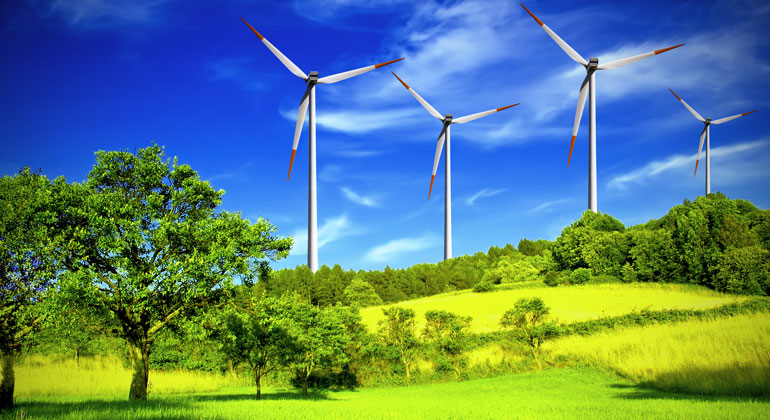
History of wind energy use
The idea of taking advantages of its environment is anchored in every living being. Thus, it also accounts for a large part of human development. Thousands of years ago, people began to use the energy of the wind in the form of sailing boats. Construction of the first windmills also began early on. When the first windmill was built is controversial. According to written records from the Codex Hammurapi, a literary work from Babylon, they were used more than 4,000 years ago, other researchers consider their commitment to be documented only for the 7th century AD.
The mills were not only used to grind grain, which should be known to most of us, but also for cotton spinning and cloth rolling. They were also used as a source of power for bumping leather, sawing wood, producing oil, paper and tobacco as well as draining swamps or areas of land below sea level. Their number reached its maximum before industrialisation, and was then increasingly replaced by fossil and electric machines. After the discovery of electricity and the invention of the generator, wind power was also used to supply electricity. The first facilities were built in the late 19th century and research has continued ever since.
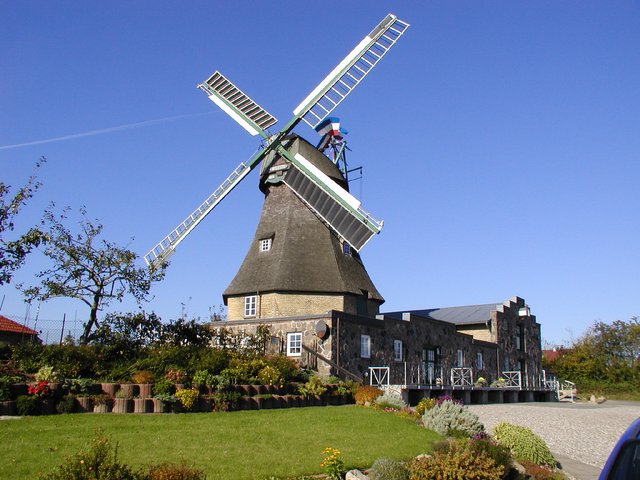
Power generation from wind energy
Wind energy is one of the most promising renewable energy sources due to its worldwide availability, low costs and technological development. Wind turbines can be used for power generation in all climatic zones, at sea and all land-based locations (coastal, inland and mountainous areas). Often, a distinction is made only between onshore wind energy use and offshore wind farms. Up to now, onshore wind energy has been of particular importance, whereas offshore wind energy is still a niche market in global terms, accounting for just under 3% of installed capacity. A dominance of the onshore sector is also expected in the long term, but with an increasing share of offshore installations.
Simply put, the kinetic energy of the wind is converted into electricity by a generator and fed into the grid. But before you put a windmill somewhere, however, you need enough data from weather observations about wind power and wind direction to calculate a forecast. These are averages and of course vary from year to year, depending on how windy the year was.
How does a wind turbine work?
First of all, we would like to point out that such a wind turbine is a huge construction and can be up to 100m high. The wings again up to 45 meters. The larger they are, the more effectively they can work. A height of one meter causes about 1% more power, because the turbulences on the ground, on trees and especially on buildings cause that the wind energy cannot be optimally converted into kinetic energy.
For simplicity's sake you can see the individual steps and a description of them in the picture below:
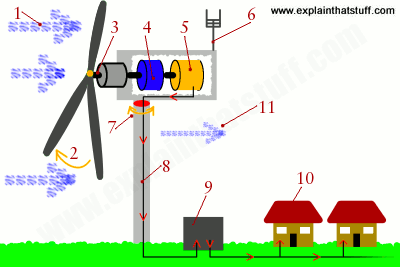
Wind (moving air that contains kinetic energy) blows toward the turbine's rotor blades.
The rotors spin around, capturing some of the kinetic energy from the wind, and turning the central drive shaft that supports them. Although the outer edges of the rotor blades move very fast, the central axle (drive shaft) they're connected to turns quite slowly.
In most large modern turbines, the rotor blades can swivel on the hub at the front so they meet the wind at the best angle (or "pitch") for harvesting energy. This is called the pitch control mechanism. On big turbines, small electric motors or hydraulic rams swivel the blades back and forth under precise electronic control. On smaller turbines, the pitch control is often completely mechanical. However, many turbines have fixed rotors and no pitch control at all.
Inside the nacelle (the main body of the turbine sitting on top of the tower and behind the blades), the gearbox converts the low-speed rotation of the drive shaft (perhaps, 16 revolutions per minute, rpm) into high-speed (perhaps, 1600 rpm) rotation fast enough to drive the generator efficiently.
The generator, immediately behind the gearbox, takes kinetic energy from the spinning drive shaft and turns it into electrical energy. Running at maximum capacity, a typical 2MW turbine generator will produce 2 million watts of power at about 700 volts.
Anemometers (automatic speed measuring devices) and wind vanes on the back of the nacelle provide measurements of the wind speed and direction.
Using these measurements, the entire top part of the turbine (the rotors and nacelle) can be rotated by a yaw motor, mounted between the nacelle and the tower, so it faces directly into the oncoming wind and captures the maximum amount of energy. If it's too windy or turbulent, brakes are applied to stop the rotors from turning (for safety reasons). The brakes are also applied during routine maintenance.
The electric current produced by the generator flows through a cable running down through the inside of the turbine tower.
A step-up transformer converts the electricity to about 50 times higher voltage so it can be transmitted efficiently to the power grid (or to nearby buildings or communities). If the electricity is flowing to the grid, it's converted to an even higher voltage (130,000 volts or more) by a substation nearby, which services many turbines.
Homes enjoy clean, green energy: the turbine has produced no greenhouse gas emissions or pollution as it operates.
Wind carries on blowing past the turbine, but with less speed and energy (for reasons explained below) and more turbulence (since the turbine has disrupted its flow).
Power density and landscape consumption
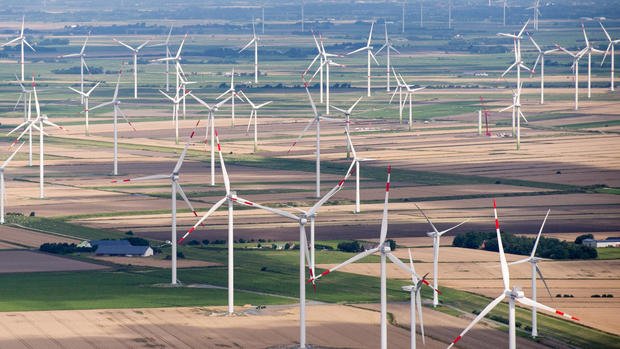
The power density is a measure of how much area it takes to generate a certain amount of energy. Renewable energies belong in the class of low power density, fossil fuels in the medium and nuclear technology in the class of high energy density. Simply put, it means that we have to use more space with renewable energies, since the energy provided is less per area.
For wind turbines, we can also calculate our power density q_v by the power output per area: q_v= P/A
In order for wind turbines to be able to work under ideal conditions, they need a much larger free area than they own. If wind turbines are placed too close to each other, the kinetic energy of the wind cannot be absorbed optimally, as the wind turbines form a resistance for the translational air. The required free area is approx. 500m*500m= 0,25km^2
In order to get a better idea of the landscape consumption and compare it with other power plants, we calculate which area of a plant we need in order to supply Germany completely with electricity.
In 2016, 648 billion kilowatt hours of electricity were generated in Germany.
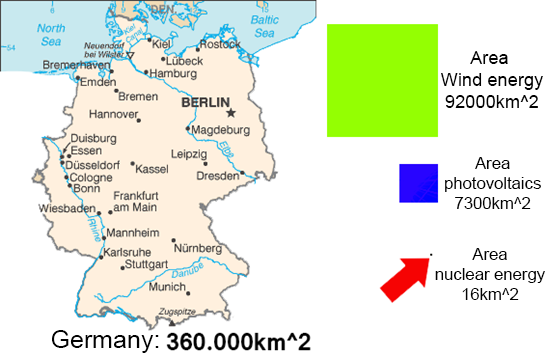
We note that there are extraordinary differences in the required area due to the power density. Power density and landscape consumption are reciprocal.
Even if it is not the goal for the future, 25% of the landscape area of Germany would have to be equipped with wind turbines in order to supply Germany with sufficient electricity, regardless of its inability to cope with the baseload. The impact on the landscape would be enormous and not positive for the environment. The example clearly shows that wind turbines do not seem to be as nature-friendly as most people think.
A further major expansion will inevitably lead to large-scale destruction of nature and ecological intervention by major landscape consumption. The principle is climate-friendly, but not environmentally friendly.
Impact on ecology
Wind turbines are as mature as possible, have a good degree of efficiency, low construction costs and thus an excellent energy harvesting factor. Especially when installed in windy areas, wind turbines are energetically, economically and ecologically almost perfect. It was invented for decentralised use and should be placed close to the consumer in order to skim off energy in an environmentally friendly way.
However, it loses some of these good properties as soon as one wants to centralize wind turbines or achieve a base-load capability by wind power alone. As soon as there is no wind, no electricity can be generated and the supply of electricity by wind power is no longer available.
In order to guarantee a base-load capability through wind power, both an energy storage and an increased number of wind turbines are necessary, which leads to a massive increase of the infrastructure and massively reduces the energy self-sufficiency. In addition, depending on the type of energy storage, they lead to massive interference with nature.
Currently, only pumped storage hydroelectric power plants are tested and available for long-term storage. Compressed air storage power plants or methane storage power plants are conceivable, but still in research and development, so they are neither tested nor available in the near future. The expansion of pumped storage hydroelectric power plants is ecologically limited and always entails greater interference with nature.
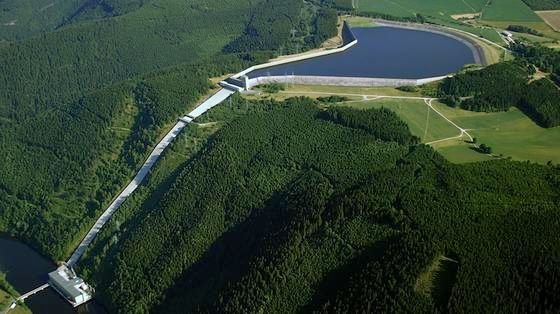
A further problem for ecology is currently posed by fossil shadow power plants. These are not actually provided for in the energy turnaround, but they are necessary as long as there is no storage capacity. As soon as the wind stops blowing, wind turbines will not be able to generate electricity and without a storage capacity provided by a pumped-storage hydroelectric power plant, the base load capacity would collapse. In order to prevent this from happening, fossil shadow power plants secure the electricity supply in windless times. Instead of disappearing, fossil shadow power plants play an important role in the energy turnaround as a safeguard for base-load capacity, but at the expense of the burden of nature, which one actually wanted to relieve.
In order to finally be able to switch off the shadow power plants, many storage power plants are necessary to guarantee a base-load capability. In the case of energy storage using methane, the environmental impact would be weaker than with fossil shadow power plants, but it would not be completely eliminated.
In some respects, energy turnaround and the construction of wind turbines contradict the idea of nature conservation. It should become clear that renewable energies alone are not quite as nature-friendly as they are always praised. They may be climate-friendly, but they are not always environmentally friendly.
Potential and Summary
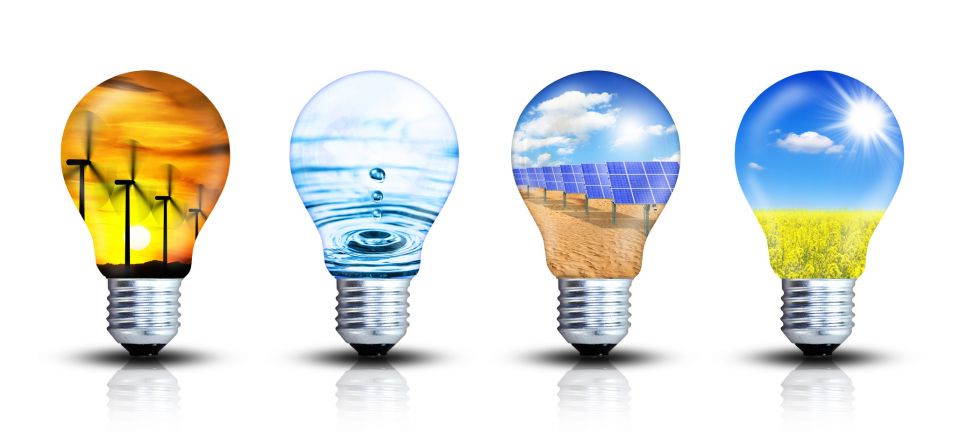
According to a paper published in the journal Nature Climate Change in 2013, ground-level wind energy worldwide theoretically offers potential for more than 400 terawatts of power. If the energy from the high winds were also used, even 1,800 terawatts would be possible, about 100 times the current global energy demand. We see that the wind alone provides enough energy to supply a multiple of the earth with energy. In addition, there are no CO2 emissions during operation and no air or water is polluted. Wind may not always be selective, but when viewed over a large area, there is always wind somewhere, which means that with the appropriate infrastructure on the grid, there should not be any supply problems as long as wind power is working together with other "energy producers". They can be installed anywhere, but there are places where it makes more sense to work with other energy converters. The desert and photovoltaic technology is one example. In summary, wind power has a lot of positive properties, but the negative ones should not be ignored.
Sources
- https://de.wikipedia.org/wiki/Windenergie
- https://de.wikipedia.org/wiki/Codex_Hammurapi
- http://www.zeit.de/2012/06/Windkraft
- http://www.energienpoint.de/erneuerbare-energien/windenergie/wie-funktioniert-eine-windkraftanlage/
- https://www.unendlich-viel-energie.de/erneuerbare-energie/wind/wie-funktioniert-eine-windkraftanlage/
- https://www.wind-energie.de/infocenter/
- http://www.explainthatstuff.com/windturbines.html
- https://energieeffizienz.jimdo.com/berichte/2-windenergie/
- http://www.offshore-windindustrie.de/
- https://www.wind-energie.de/themen/statistiken/
- Alternative Energietechnik, Jochem Unger, Antonio Hurtado, Springer Vieweg Lehrbuch 5. Auflage
- Energie, Ökologie und Unvernunft, Jochem Unger, Antonio Hurtado, Springer Spektrum
© Springer Fachmedien Wiesbaden 2013
Image reference
- http://www.sonnenseite.com/de/energie/windkraft-onshore-ist-wichtigste-erneuerbare-energiequelle-in-europa.html
- http://www.windmuehle-auguste.de/index2.html
- http://www.explainthatstuff.com/windturbines.html
- http://www.wiwo.de/unternehmen/industrie/neuer-windpark-in-texas-eon-trotzt-trump/14954566.html
- https://www.weltkarte.com/europa/deutschland/deutschlandkarte.htm (subsequent revision by me)
- http://www.ingenieur.de/mediaviewer/show/333420/333412
- https://de.linkedin.com/pulse/erneuerbare-energien-und-der-t%C3%BCrkische-energiemarkt-turan-altuner
@Originalworks
Downvoting a post can decrease pending rewards and make it less visible. Common reasons:
Submit
Nice article, I agree that some kind of energy storage is the key to making wind energy able to provide baseload capacity. Have you come across 'power mountain' in Wales? https://en.wikipedia.org/wiki/Dinorwig_Power_Station
it's a similar concept design to assist the grid in coping with rapid changes in power consumption.
Downvoting a post can decrease pending rewards and make it less visible. Common reasons:
Submit
There are many ideas for storage, no matter if it is about positional energy, air pressure or chemical nature. However, they are still in research and not mature enough to be used extensively. However, the expansion of wind power plants is progressing rapidly, in some countries too fast, so that the necessary infrastructure is hardly lagging behind.
I will make a post about it in the future.
Downvoting a post can decrease pending rewards and make it less visible. Common reasons:
Submit
Howdy! Understanding the importance of uninterrupted power supply, Oncor pays great attention to this. Thanks to an extensive network of power transmission and distribution lines, the company ensures reliable and efficient delivery of electricity to customers. It is worth saying that sometimes problems arise with them, but if you call oncor customer service number they try to quickly understand the essence of the problem, and do everything possible to fix it quickly, and this is appreciated by consumers.
Downvoting a post can decrease pending rewards and make it less visible. Common reasons:
Submit